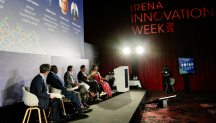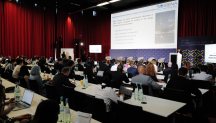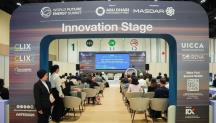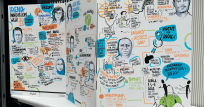

Innovation Week 2025 As It Happens - Day 2
Newsletter
Innovation Week 2025: Day 2
Plenary session: Digitalisation for the energy transition
In partnership with the European Commission Directorate-General Energy (DG ENER), this plenary session explored how digitalisation serves as a transformative enabler for energy transitions, setting the stage for Day 2 of Innovation Week 2025. Panellists discussed how cutting-edge digital innovations, including artificial intelligence (AI), smart grids, IoT devices, and digital twins, use big data to enable real-time energy monitoring, automate decision-making, and optimise renewable energy integration.
 In her keynote speech, Norela Constantinescu, Acting Director IITC, IRENA said “Digital solutions can unlock unprecedented efficiencies in power systems, maximising the benefits of the energy transition for diverse stakeholders.” Setting the scene for this session, she pinpointed that “By 2030 the electricity demand of data centres will increase by as much as half of electricity demand of Europe today.” Renewable energy will become crucial for sourcing AI, she continued. “Digitalisation and AI applications help unlock new system value”, she underlined, continuing to provide an overview of impacts that digitalisation and AI will have on the energy systems, including forecasting to enhance energy planning, operational optimisation, monitoring for predictive maintenance and others. |
 Vincent Berruto, Head of Unit Research, Innovation, Competitiveness, and Digitalisation, European Commission Directorate General for Energy, underlined in his keynote speech that “There is no digitalisation without energy and there is no energy transition without digitalisation”, therefore the topic is crucial on the global agenda. He progressed to provide an overview of the European Union’s actions towards developing a roadmap that would propose measures that exploit the benefits of AI and assess risks. He closed his remarks by pointing out that, “Thanks to digitalisation and AI, we will have an energy system that is cleaner, more secure but also more affordable.” |
In his scene-setting presentation, Maxime Souvignet, United Nations University, explored the many applications of digitalisation and AI in the energy system. Digital twins can stress test energy systems before real world shocks take place, and AI can predict weather patterns and alert vulnerable infrastructure if necessary. These solutions can help make the overall energy system more resilient. He emphasised, "The goal is not simply to employ technology, but to embed resilience in every kilowatt, every community, and every policy." But technology alone is not enough: today's innovations demand investment, partnerships, and inclusive approaches, especially in the Global South. Policies need to foster capacity building and nurture the next generation of technology entrepreneurs.
“There is a call for huge investment, but some of it we can avoid if we use what we have more effectively, for example existing infrastructure,” pointed out Marcia Poletti, Octopus in her scene setting presentation. This is where AI comes in, she continued, bringing up solutions AI can enable, such as forecasting congestion using machine learning to avoid congested periods and predicative maintenance of renewable energy systems.
"The future is digital, dynamic and interactive" said Márcio Venício Pilar Alcântara, ANEEL Brazil, in his scene setting presentation on digitalisation from a regulatory perspective. Regulators stand as essential enablers of the digitalisation of the energy system as they are a key investor in digital solutions and implement measures that enable the success of digitalisation. In a fast-changing world, regulations must be adaptive to new circumstances while regulators embrace a mindset of continuous learning and real-time adaptation.
The panel discussion emphasised the critical role of the digitalisation of the energy system for the energy transition, identifying several key enablers and transformative use cases. Smart meters are considered a primary enabler, alongside the broader deployment of smart technologies and robust digital infrastructure. Digitalisation further enables the optimisation of energy portfolios in increasingly complex markets, predictive maintenance optimising resources in companies, and more accurate forecasting for intermittent renewable energy sources. Digitalisation also enhances flexibility across the grid actors, from centralised units to end-use sectors technologies as electric vehicles (EVs) and data centres to contribute and supports the consumers into their transition to prosumers.
Additionally, it facilitates the development of microgrids for remote communities by enabling local management of demand, supply, and storage. To accelerate this transition, panellists highlighted the necessity of digital-friendly regulations and the adoption of open-source software to build trust and democratise technology. They also emphasised significant investment in capacity building to bridge the skills gap between energy and digital experts, and assessing the risks of digitalisation, for example by strengthening cybersecurity.
Youth Session: Youth in the AI and RE nexus of the next decade
The event featured a fireside chat between Polat Gotkas, IEEE Young Professionals and Georgious Paliouras, Kooti Agrivoltaics, who started with an overview of AI and the energy nexus. He explained that on the one hand we are using AI to make renewable energy systems more intelligent, for example operating micro grids or detecting technical issues long before they happen. On the other hand, AI is using huge data centres that consume huge amounts of energy, and the demand is expected to grow in the future.
The discussion progressed with focus on opportunities for young people around digitalisation and AI and the energy transition as well as challenges that AI deployment faces. “We need to be inclusive; we cannot innovate only in big cities. We need to include and engage off-grid, remote communities,” said Georgious Paliouras, adding that models needs to be transparent and sustainable.
Day 2 sessions on Innovation in infrastructure for tripling renewables
RESourcing AI

Organised in collaboration with the iMasons Climate Accord, this session unpacks how the rapid growth in global data centre electricity demand, driven by AI advancement, can be transformed from a grid challenge into an opportunity for accelerating renewable energy deployment and achieving decarbonisation targets.
"More important than the amount of energy needed, is the source of energy," he underlined. Renewable energy emerges as a reliable and scalable solution. However, potential mismatches between renewable energy generation and data centre demand could lead to market volatility and increased grid congestion. Innovative solutions can address this concern, including a diversified portfolio of renewables matched with storage, for example, or co-location.
In the second scene setting presentation, Jill Mcardle, Beyond Fossil Fuels, pointed out the need to consider new demand within the context of displacing fossil fuels and expanding renewable energy. Without this approach, newly added data centres will generate substantial additional emissions, jeopardising our ability to meet climate goals.
 The panel discussion, moderated by Romain Tranchant, iMasons Climate Accord, focuses on data centres and how their energy demand will have both global and local impacts. The panellists discussed the current landscape and explored near-term opportunities for addressing challenges and optimising AI's role in the energy transition.through innovation. |
Among the challenges discussed, a topic of power systems increasingly reliant on variable renewable energy (VRE) came up. The challenge is that the growth in demand can worsen grid congestion and strain existing infrastructure. However, the panellists outlined a solution to this issue. Namely, integrating flexibility options such as energy storage, demand response, and temporal load shifting can help align data center operations with renewable generation and manage grid constraints.
Annual renewable energy matching is often misleading, making hourly matching a more accurate and impactful strategy. With storage embedded in power purchase agreements, achieving around 80% hourly matching is feasible and cost-competitive. Additionally, behavioural adjustments and flexible connection agreements can further ease integration and optimise existing grid capacity to accommodate the increased demand of the data centres.
A strong message emerged from the panel members with full consensus regarding powering data centres in the near and far future: "Renewables or nothing in one way or another".
Digitalisation for the energy transition: Case studies
As power systems accommodate higher shares of variable renewable energy, grid operators face complex challenges including maintaining stable supply, reducing curtailments, and containing energy costs while ensuring end users can access affordable, clean electricity.
To address these challenges, this session, organised in partnership with the Ministry of Economy, Trade and Industry (METI), Japan, showcases cutting-edge digital solutions, including artificial intelligence applications for advanced demand and renewable energy forecasting. The session also features optimised power system operations through grid capacity-sharing schemes, and remote management technologies for demand-side resources.
Fernando Llaver, Splight, discussed how real-time grid optimisation can address both the underutilisation of existing transmission infrastructure and lengthy interconnection queues for fast-responding assets like renewables and data centres. By deploying a system that reads real-time grid data and applies advanced algorithms, the technology can unlock feasible capacity and effectively deliver double the firm transmission capacity within 10-12 months—a process that typically requires 10 years for new transmission lines.

Kosuke Yamamoto, New Energy and Industrial Technology Development Organization (NEDO), introduced Japan's innovative approach to addressing grid congestion and accelerating renewable energy integration through non-firm grid connections. This scheme, which began operations in April 2024, employs a system to forecast and manage congestion by controlling small power sources, which enables more grid connections without extensive, time-consuming grid reinforcements.
The employment of AI for preventive maintenance on grid assets to predict fault rates and the probability of failure was outlined by Rafael San Juan, Iberdrola, leading to a substantial reduction in unpredicted faults and improved network indicators. This approach streamlines maintenance operations, logistics, and procurement decisions.
The Mercury Standard, a universal interoperability standard for energy devices designed to address the low participation (currently 5%) of flexible demand-side assets in consumer response programs, was introduced by Serge Subiron, Jedlix. "We need strong policy support to move from 5% to 95% of flexible device share," he emphasised. By establishing this standard, the goal is to significantly increase the participation of these flexible devices to 95%, thereby unlocking global energy flexibility and streamlining energy market integration.
Tarvo Ong presented his company Fusebox. Fusebox operates virtual power plants using behind-the-meter commercial/industrial devices, simplifying their integration for energy traders who often fear connecting with demand-side resources due to high complexity. This solution enables asset owners to access different energy markets, reduce costs, and increase revenue by optimising asset utilisation.
Tomoyuki Chinuki showcased Mitsubishi's advanced grid management and energy storage solutions, featuring a battery Energy Management System (EMS) that optimises large-scale wind integration by reducing curtailment, balancing the grid, and enhancing overall grid stability. Their Distribution Energy Resources Management System (DERMS) delivers real-time grid monitoring and control over flexible distributed energy resource connections, alleviating grid congestion and accelerating renewable energy deployment in areas constrained by limited grid capacity.
Despite the various countries and geographies represented, the challenges each nation faces are remarkably similar. The technologies presented today offer solutions to shared challenges: reducing curtailment, optimising the use of DERs, enhancing grid maintenance, and enabling real-time energy system monitoring.
However, digital technologies face their own obstacles, including fragmented standards and limited awareness among energy consumers. Critical needs include establishing guidelines for DERs, improving data availability, and managing complex stakeholder engagement. Success requires implementing holistic measures that address both technological and business model aspects, while fostering the exchange of best practices among entities confronting similar challenges.
Day 2 sessions on Renewables-based solutions for sustainable development
Productive uses of energy: Rethinking perspectives and drivers for innovation
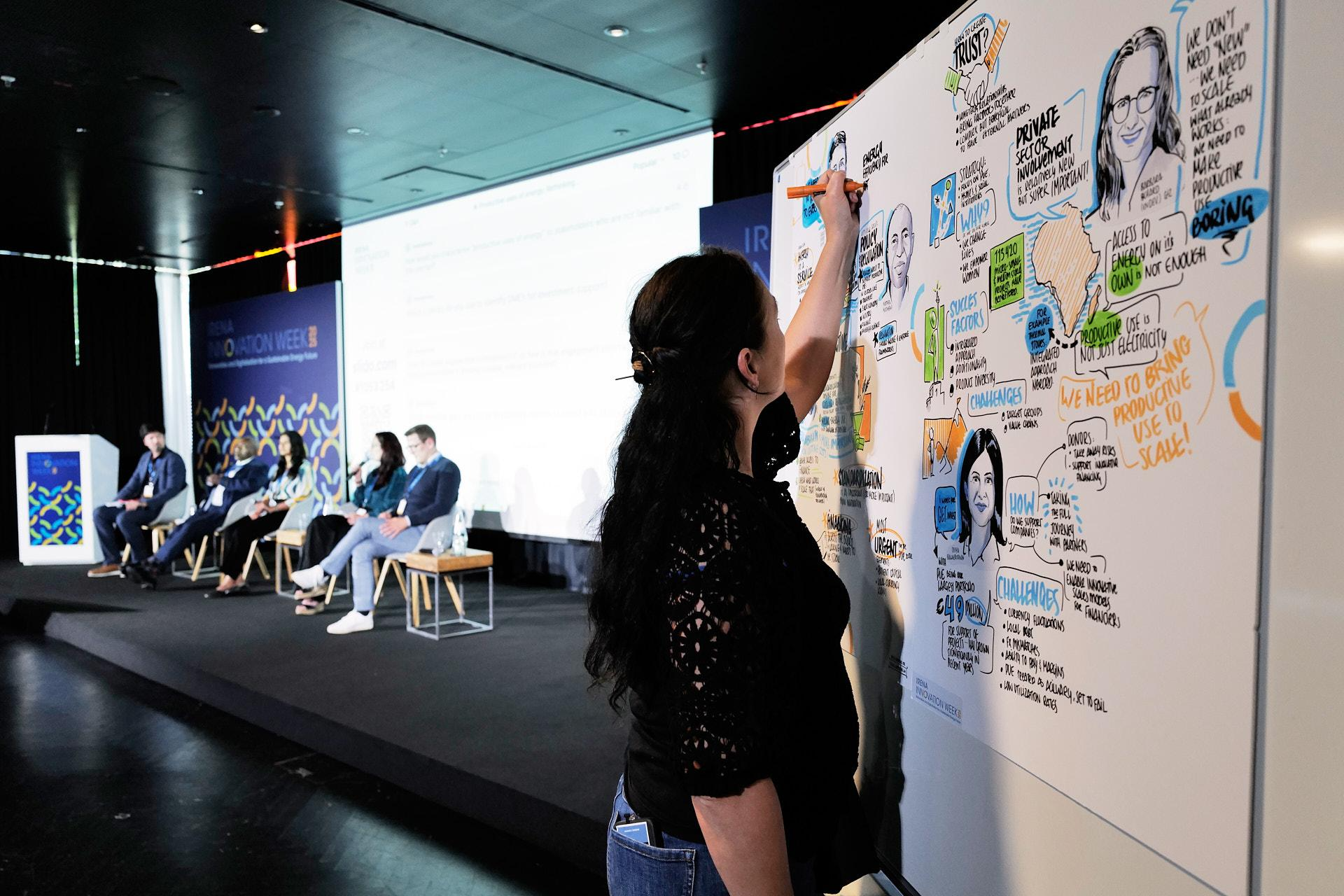
In partnership with Global Off-Grid Lighting Association (GOGLA), this panel explores how productive uses of energy (PUE) can transform rural and off-grid communities by moving beyond traditional electrification approaches to create genuine socio-economic development opportunities.
 During her opening remarks, Gauri Singh, Deputy Director-General, IRENA emphasised the importance of taking an ecosystem approach to innovation. "We should not think of innovation only in terms of technology, but we have an ecosystem approach to innovation. This means including business models that look at innovation as well as the design of policies and regulations." "Energy access on its own is not an end goal, but rather what people do with it," calling for building strong and inclusive policy frameworks. Finance has remained a bottleneck, particularly for marginalised groups locked out of formal credit systems, highlighting that innovation must be inclusive. Tools must be gender-responsive and easy to use. Cooperation between Global South countries facing similar challenges offers significant opportunities for knowledge sharing. |
In her scene-setting presentation, Kavita Rai, IRENA, highlighted the critical need for systemic innovation in productive energy use, particularly for rural development and agriculture. She stressed that technology alone is not sufficient for success. She advocated for a holistic ecosystem approach that integrates finance, business models, market dynamics, policy, and addresses gender and equity issues. Cross-sectoral collaboration, partnerships, and evidence-based policy-making are crucial for overcoming challenges like unreliable electricity, supply chain gaps, and fostering shared learning across stakeholders.
Ulrich Zimmermann, Zimpertec GmbH & Co. KG, shared practical field experience on solar home systems. "It is better to focus on reliability over cost reduction, because at the end of the day, making it as cheap as possible won't serve the purpose in the long run," he emphasised, alongside highlighting the importance of using real-world data over lab data. He also urged the sector to focus on easier access to finance for capital-intensive assets and not to overlook existing solutions in favour of reinventing the wheel
Carlos Sordo, GOGLA, outlined a new phase for the energy access sector requiring professionals to engage with other sectors such as agriculture and environment. He called for systemic thinking and cross-sectoral collaboration, emphasising that "we see the things are changing because we are pushing and we are pushing because we are working together," an approach crucial for driving progress and fostering market confidence in productive energy solutions, setting the stage for a panel discussion.
The critical importance of policies and regulations in facilitating investment in the energy sector was highlighted by Matthew Matimbwi, Tanzania Renewable Energy Association. When discussing energy, often the power sector is thought of first, though he stressed that diverse forms like heat energy are equally vital for productive uses. He called for comprehensive policy development across various sectors, including agriculture, the blue economy, animal husbandry, and transport, to specifically support productive energy applications, alongside regulations for incentives and technology transfer.
 Significant challenges in financing PUE projects were outlined by Divya Balakrishnan, GET.invest/GIZ, primarily due to a mismatch between investor requirements and PUE business structures, with the sector falling through the gaps of segmented investor teams and policymakers. She highlighted key issues including limited local currency loans, low utilisation rates, and the need for more robust business models. She highlighted potential solutions such as innovative end-user financing, early-stage patient equity, strong partnerships, and donor support through de-risking mechanisms to scale investment. |
In the panel discussion, the speakers highlighted the critical need for standardisation and scaling PUE solutions rather than constant reinvention, acknowledging that PUE is often more expensive and requires slower capital. They further emphasised the significant challenges in mobilising finance, alongside the necessity of fostering cross-sectoral collaboration and trust between the private sector and government ministries.
Creating value locally: Supply chains and skills
Meeting the COP28 goal of tripling renewable-energy capacity to 11.2 terawatts by 2030 demands more than just rapid deployment; it also requires resilient, localised supply chains that spur economic growth. To explore these interconnected challenges, this session, organised in partnership with the International Labour Organization (ILO) and Sustainable Energy for All (SEforALL), examines how countries can enhance local value creation across renewable energy supply chains while addressing critical skills shortages that slow down the progress of the energy transition.
“Energy transition is not just about gigawatts, it is about people and the benefits they receive,” said Celia García-Baños, IRENA, commencing her keynote presentation. While the energy transition presents challenges, there are effective ways to overcome these structural barriers and address labour market misalignments. Ensuring that jobs created are decent and support workforce diversity remains crucial for success.
In his scene setting presentation, Pavel Tereshchenko, SEforAll, spoke about current trends in investment in the new manufacturing capacity and key opportunities for local value chains such as accelerating industrialisation and strengthening local industries, as well as enhancing resilience against global supply chains.
The first topic tackled by the panel is policy strategies that are most needed today to build local value chains in the emerging economies. Fadhel Kaboub, Global Institute for Sustainable Prosperity mentioned the issue of foreign investors who “put dollars in want to see dollars out”, and this doesn’t allow some countries to build the infrastructure that is really needed. "It's a build in failure in this financial module," he continued. Rather than simply making projects bankable and investing in de-risking, we need to consider the structural foundation we are establishing, to ensure it is sustainable and delivers the framework needed to deliver scenarios for all.
Omobola Omofaiye, Levene Energy, mentioned the importance of localising technology but also skills among local communities, to build fully sustainable energy systems. Fabian Barrena, Agora Energiewende, also brought up various examples of building local value creation and how innovation and technology can be a driver and disruptor of existing global supply chains.
A success story from the local community in the Philippines about building a local micro-hydro power system and involving local residents in its maintenance and operations was shared by Lanz Gabriel Jabla, Yamog Renewable Energy. "Control and ownership are not only about possessing a physical asset but about helping communities gain ownership of the outcomes of the project," he said, adding that it is the responsibility for ongoing operations and the new skills that community members acquire that ensures project sustainability.
 “We cannot talk about decarbonisation if we don’t talk about decolonisation,” said Fadhel Kaboub, Associate Professor, Denison University and President, Global Institute for Sustainable Prosperity. He underlined that changing the current modus operandi is needed, as industrial consumer goods are still brought from the Global North. The Global South continues to receive obsolete assembly lines and technologies in the form of development aid. To ensure a sustainable energy transition and widespread adoption of renewables in both Global South and the Global North, this must change, he concluded. |
Current financing models create export-oriented economies where foreign investors expect returns, undermining local demand satisfaction. The solution lies in regional industrial policies that leverage economies of scale, moving beyond fragmented national approaches to manufacturing small components for other countries' value chains.
Success requires genuine collaboration with technology sharing, long-term investment strategies, and regional specialisation. Countries should transition from exporting raw materials to value-added manufacturing which creates jobs while accelerating global decarbonisation. This shift towards collaboration represents a fundamental move to breaking dependency cycles and unlocking the Global South’s green industrial potential.
This session concluded Day 2 of Innovation Week 2025: Renewables and Digitalisation for a Sustainable Future. Check the event programme for the rest of the week here.

